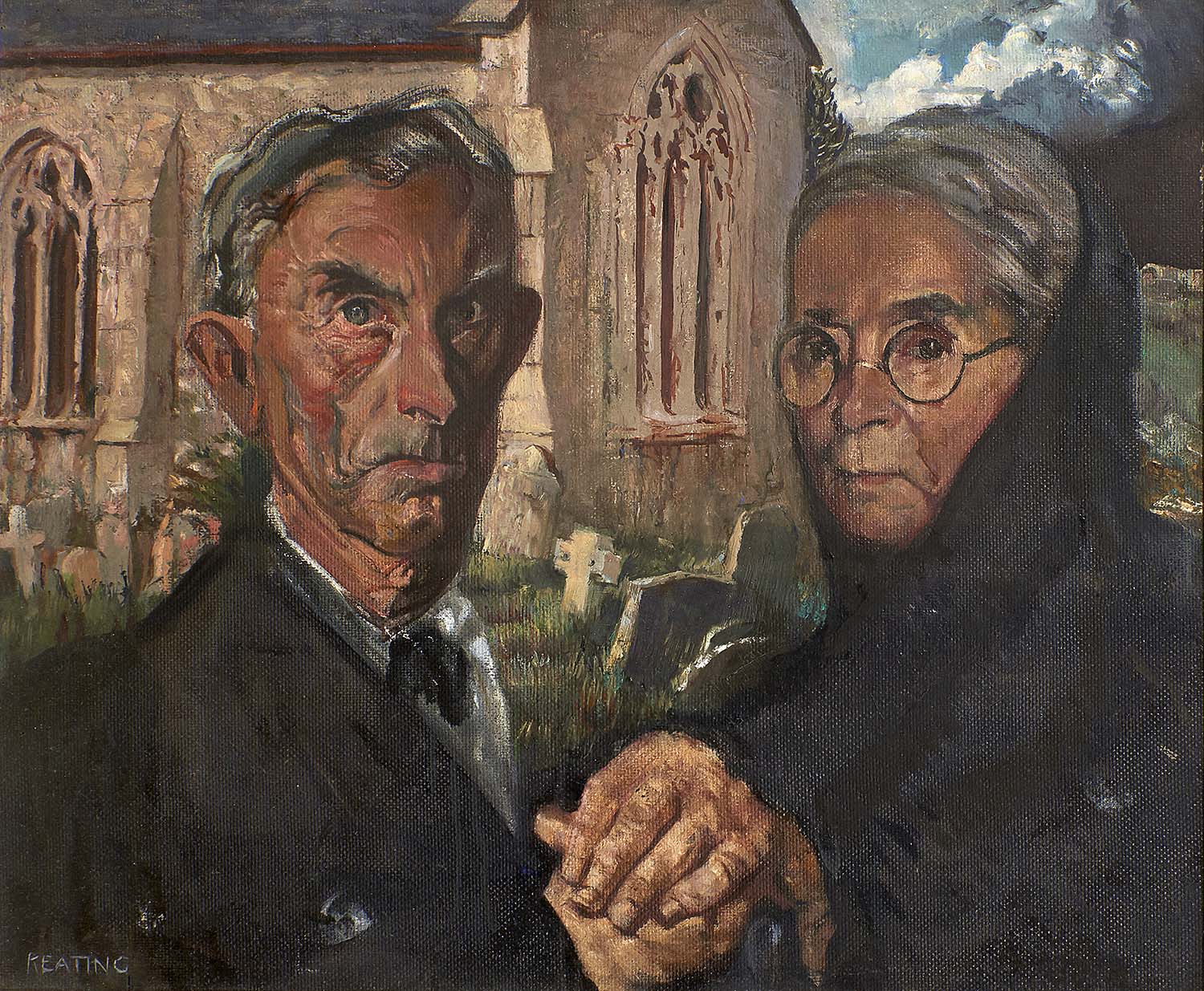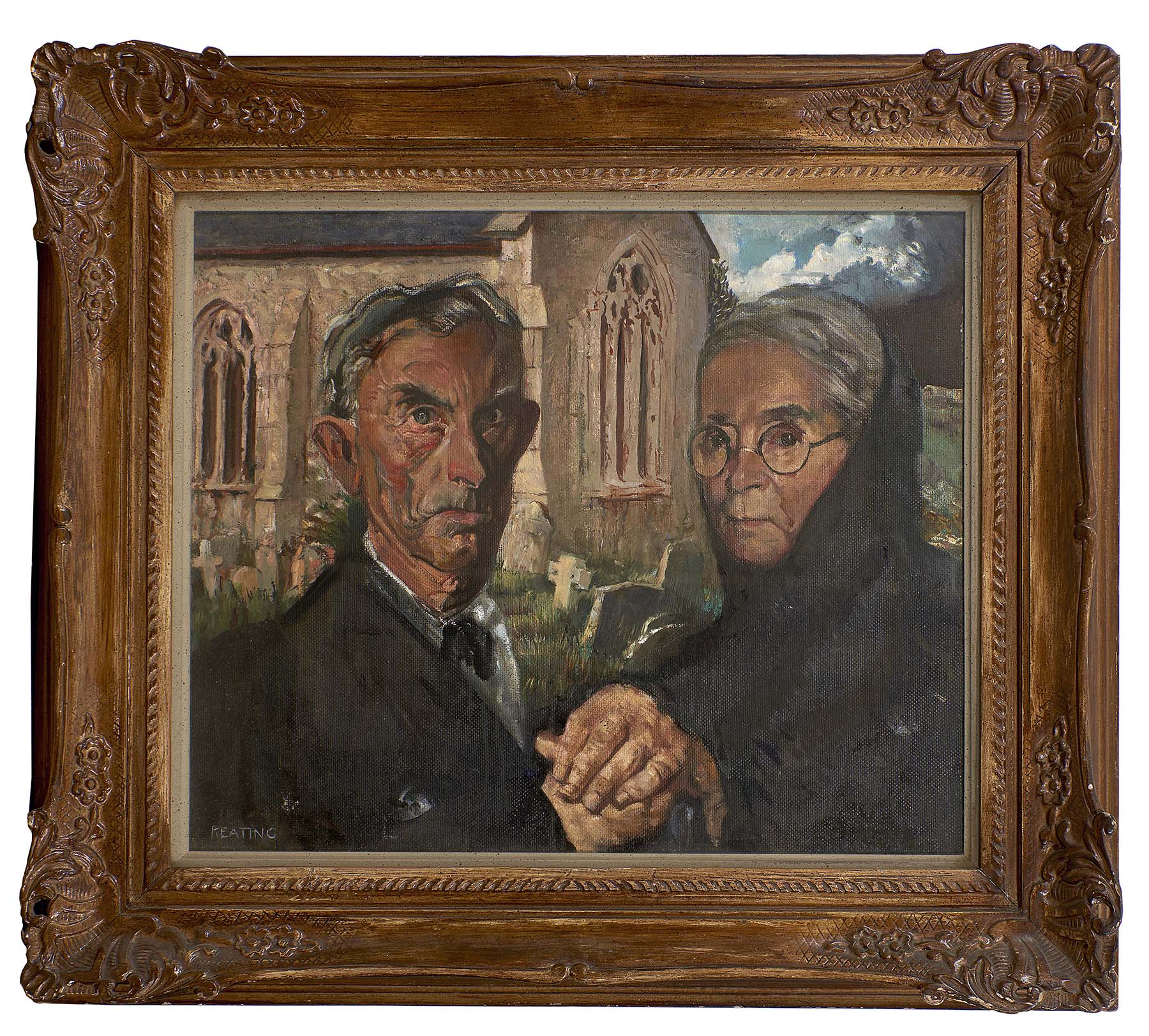14
IRISH GOTHIC by Sean Keating RHA
1/2
Description
Seán Keating (1889-1977), PPRHA, HRA, HASIRISH GOTHIC (1950)Oil on canvas, 19” x 24” (48.2 x 61cm), signed. Exhibited: RHA 1950Irish artist, Seán Keating, began thinking about Irish Gothic in 1948 as a pendant to a previous work, Irish Romanesque (1943). The paintings were a continuation of his career-long habit to paint real people as opposed to models, all of whom had contributed to building the Irish nation in the post-Treaty years. The reference to architecture in the title suggests that Keating saw the same soundness and solidity in the people in the painting as analogous with the traditional structures of the land. The male portrait in Irish Gothic is loosely based on a series of sketches that the artist made in Kiskeam, Co. Cork for a painting titled Republican Court (otherwise known as Sinn Fein Court), planned with the help of Seán Moylan, then Minister for Land and Fisheries, in 1945. The sketches for the painting were made in Seán Moylan’s old family home in Kiskeam, Co. Cork, and the men who posed for the painting had all fought in the War of Independence. It is thought that name of the man portrayed in Irish Gothic is Michael T. Cronin who is seated second from the left in Republican Court.The portrait of the woman is based on one of Keating’s sisters, Vera (1895-1953). Keating and his six siblings were born and raised in Limerick city. While the rest of the family moved to Dublin at various intervals between 1911 and 1913, Vera remained to train as a teacher in Mary Immaculate College in Limerick, graduating in 1916. Having spent a few years working in England, she returned to Limerick and spent her career teaching at the old St John’s School, near the city centre. Vera modelled for several of Keating’s earlier works including Girl in a Black Fur Coat (1916) (private collection) and The Festival of St Brigid (1918) (private collection). In later years the two siblings got on well; Keating often visited her in Limerick, and lent paintings to local exhibitions with which she was involved. Elected President of the RHA in March 1950, Keating exhibited Irish Gothic in the annual exhibition that year. To his deep regret, Vera died in 1953, after which the artist thought of the painting as a tribute to her.Dr Éimear O’Connor HRHAResearch AssociateHumanities Institute, UCDMay 2019
Auction Details
Shipping
T&Cs & Important Info
Ask seller a question
Seán Keating (1889-1977), PPRHA, HRA, HASIRISH GOTHIC (1950)Oil on canvas, 19” x 24” (48.2 x 61cm), signed. Exhibited: RHA 1950Irish artist, Seán Keating, began thinking about Irish Gothic in 1948 as a pendant to a previous work, Irish Romanesque (1943). The paintings were a continuation of his career-long habit to paint real people as opposed to models, all of whom had contributed to building the Irish nation in the post-Treaty years. The reference to architecture in the title suggests that Keating saw the same soundness and solidity in the people in the painting as analogous with the traditional structures of the land. The male portrait in Irish Gothic is loosely based on a series of sketches that the artist made in Kiskeam, Co. Cork for a painting titled Republican Court (otherwise known as Sinn Fein Court), planned with the help of Seán Moylan, then Minister for Land and Fisheries, in 1945. The sketches for the painting were made in Seán Moylan’s old family home in Kiskeam, Co. Cork, and the men who posed for the painting had all fought in the War of Independence. It is thought that name of the man portrayed in Irish Gothic is Michael T. Cronin who is seated second from the left in Republican Court.The portrait of the woman is based on one of Keating’s sisters, Vera (1895-1953). Keating and his six siblings were born and raised in Limerick city. While the rest of the family moved to Dublin at various intervals between 1911 and 1913, Vera remained to train as a teacher in Mary Immaculate College in Limerick, graduating in 1916. Having spent a few years working in England, she returned to Limerick and spent her career teaching at the old St John’s School, near the city centre. Vera modelled for several of Keating’s earlier works including Girl in a Black Fur Coat (1916) (private collection) and The Festival of St Brigid (1918) (private collection). In later years the two siblings got on well; Keating often visited her in Limerick, and lent paintings to local exhibitions with which she was involved. Elected President of the RHA in March 1950, Keating exhibited Irish Gothic in the annual exhibition that year. To his deep regret, Vera died in 1953, after which the artist thought of the painting as a tribute to her.Dr Éimear O’Connor HRHAResearch AssociateHumanities Institute, UCDMay 2019
Irish Art & Sculpture
Sale Date(s)
Venue Address
35 Kildare Street
Dublin
2
Ireland
General delivery information available from the auctioneer
If delivery is required we have a number of carriers we can recommend. Please talk to a member of staff for further information.






